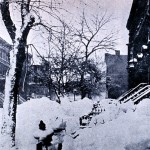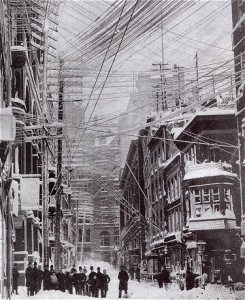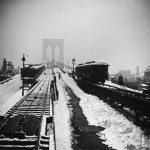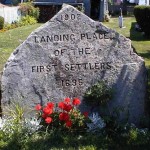east coast
 As we sit here, with an early Spring upon us, I find it an odd thing to think about another year that had been rather balmy too. The year was 1888, and things were about to get serious along the northern East Coast. The day began with rain, but as the storm really came at around midnight, the rain turned to snow, and the area began to become a nightmare right before the very eyes of the people in the area. Snowfalls of between 20 to 60 inches were seen in parts of New Jersey, New York, Massachusetts, and Connecticut. The winds howled…sustained winds of more than 45 miles per hour producing snowdrifts in excess of 50 feet. The area railroads were shut down and people were confined to their houses for up to a week. The difficult thing here is that people didn’t have some of the weather predictors that we have these days, so many of them had no idea what was coming their way, and so had far k=less time to prepare for it.
As we sit here, with an early Spring upon us, I find it an odd thing to think about another year that had been rather balmy too. The year was 1888, and things were about to get serious along the northern East Coast. The day began with rain, but as the storm really came at around midnight, the rain turned to snow, and the area began to become a nightmare right before the very eyes of the people in the area. Snowfalls of between 20 to 60 inches were seen in parts of New Jersey, New York, Massachusetts, and Connecticut. The winds howled…sustained winds of more than 45 miles per hour producing snowdrifts in excess of 50 feet. The area railroads were shut down and people were confined to their houses for up to a week. The difficult thing here is that people didn’t have some of the weather predictors that we have these days, so many of them had no idea what was coming their way, and so had far k=less time to prepare for it.
Areas of northern Vermont received from 20 inches to 30 inches in this storm, with drifts reported from 30 to  40 feet over the tops of houses from New York to New England. There were also reports of drifts covering 3 story houses. The highest drift…52 feet was recorded in Gravesend, New York. A total of 58 inches of snow fell in Saratoga Springs, New York; 48 inches in Albany, New York; 45 inches of snow in New Haven, Connecticut; and 22 inches of snow in New York City. With the snow came severe winds, with gusts up to 80 miles per hour, although the highest official report in New York City was 40 miles per hour, with a 54 miles per hour gust reported at Block Island. Central Park Observatory, in New York City, reported a low temperature of 6 °F, and a high temperature of 9 °F on March 13…the coldest ever for March. These days Winter Storms have names, but they didn’t then. Nevertheless, the storm was named the Great White Hurricane. It paralyzed the East Coast from the Chesapeake Bay to Maine, as well as the Atlantic provinces of Canada. The Telegraph was disabled because of all the downed lines, isolating Montreal and most of the large northeastern United States cities from Washington DC to Boston for days. Following the storm, New York began placing its telegraph and telephone lines underground to prevent destruction. From Chesapeake Bay through the New England area, more than 200 ships were either grounded or wrecked, killing at least 100 seamen.
40 feet over the tops of houses from New York to New England. There were also reports of drifts covering 3 story houses. The highest drift…52 feet was recorded in Gravesend, New York. A total of 58 inches of snow fell in Saratoga Springs, New York; 48 inches in Albany, New York; 45 inches of snow in New Haven, Connecticut; and 22 inches of snow in New York City. With the snow came severe winds, with gusts up to 80 miles per hour, although the highest official report in New York City was 40 miles per hour, with a 54 miles per hour gust reported at Block Island. Central Park Observatory, in New York City, reported a low temperature of 6 °F, and a high temperature of 9 °F on March 13…the coldest ever for March. These days Winter Storms have names, but they didn’t then. Nevertheless, the storm was named the Great White Hurricane. It paralyzed the East Coast from the Chesapeake Bay to Maine, as well as the Atlantic provinces of Canada. The Telegraph was disabled because of all the downed lines, isolating Montreal and most of the large northeastern United States cities from Washington DC to Boston for days. Following the storm, New York began placing its telegraph and telephone lines underground to prevent destruction. From Chesapeake Bay through the New England area, more than 200 ships were either grounded or wrecked, killing at least 100 seamen.
In New York, all transportation was at a standstill for days, and drifts across the New York–New Haven rail line at Westport, Connecticut took eight days to clear. Partly because of the transportation gridlock, it was decided that they needed a better system, and the first underground subway system in the United States, opened nine years later in  Boston. The New York Stock Exchange was closed for two days…something that almost never happens. Firefighters were unable to get to the fires, and property loss just from the fires was estimated at $25 million. Severe flooding occurred after the storm due to melting snow, especially in the Brooklyn area, which was more susceptible to serious flooding. Efforts were made to push the snow into the Atlantic Ocean. More than 400 people died from the storm and the cold that came with it, including 200 in New York City alone. Among them was former United States Senator Roscoe Conkling. The blizzard also resulted in the founding of the Christman Bird and Wildlife Sanctuary located near Delanson, Schenectady County, New York, which was listed on the National Register of Historic Places in 1970.
Boston. The New York Stock Exchange was closed for two days…something that almost never happens. Firefighters were unable to get to the fires, and property loss just from the fires was estimated at $25 million. Severe flooding occurred after the storm due to melting snow, especially in the Brooklyn area, which was more susceptible to serious flooding. Efforts were made to push the snow into the Atlantic Ocean. More than 400 people died from the storm and the cold that came with it, including 200 in New York City alone. Among them was former United States Senator Roscoe Conkling. The blizzard also resulted in the founding of the Christman Bird and Wildlife Sanctuary located near Delanson, Schenectady County, New York, which was listed on the National Register of Historic Places in 1970.
 As I have been working through some of the hints on my Ancestry tree, I am amazed by the number of family members from varying sides of my family and my husbands family, who started their life in America, or moved early in their life in America, to the same places. I don’t know if they knew each other, or even if they were there at the same time, but the roots are there nevertheless. They may not have lived in the same town even, but sometimes it was close. One state that I just keep coming up with is Massachusetts. Who would have ever thought some of my roots would have come from Massachusetts?
As I have been working through some of the hints on my Ancestry tree, I am amazed by the number of family members from varying sides of my family and my husbands family, who started their life in America, or moved early in their life in America, to the same places. I don’t know if they knew each other, or even if they were there at the same time, but the roots are there nevertheless. They may not have lived in the same town even, but sometimes it was close. One state that I just keep coming up with is Massachusetts. Who would have ever thought some of my roots would have come from Massachusetts?
Recently I started talking to a relative from my dad’s side of the family that was traced to me through DNA matching. We have been unable to connect our two trees yet, because of limited information back through the generations, but DNA doesn’t lie, and we both have Fuller relatives in our background…and both sides come from…you guessed it, Massachusetts. I have also been looking at the Shaw side of my mother’s family because of another recent connection in Ancestry, that I’m not yet sure is related or not. Nevertheless, once again, I have run into Massachusetts as their point of origin to the United States. In the Shaw family, we also find that we have a  Mayflower connection, in the form of one Lieutenant John Shaw, who arrived in America on that ship.
Mayflower connection, in the form of one Lieutenant John Shaw, who arrived in America on that ship.
Now, switch to my husband’s family, and you will find that the Noyes family, another connection I made recently, also hail from Massachusetts. I have known for some time now, that my husband, Bob Schulenberg, and I are cousins of varying degrees, depending on the side of the family you look at, and now I think I can understand how some of this might have come about. I think much of it can be traced back to Massachusetts. The connections don’t all trace there, but there are enough of them that it made me very curious about all those people who lived in Massachusetts way back then. Then I came across John Spencer, who is my 8th great grand uncle, and the Reverend James Noyes, who is Bob’s 7th great grandfather, both came over on a ship called the Mary and John, and were among the first settlers of Newberry, Massachusetts, so my suspicions are confirmed. That also brings in yet another side of my family…the Spencer side.

This will be a developing story, of course, because as I trace things further, and discuss more of the family history with these new found cousins, more information will come to light. Whenever I find these new connections, I get very excited, because you just never know where they are going to lead you. I had always through that most of my roots were in the Wisconsin/Minnesota area, but of course, that could not have been, because when our ancestors came to this country, they didn’t arrive in Wisconsin or Minnesota, but rather along the east coast, because that was the area of the nation that had been developed at that time. So in reality, I knew we came from the east coast, but Massachusetts…seriously!! I never would have guessed it.

